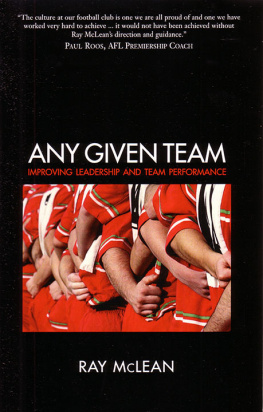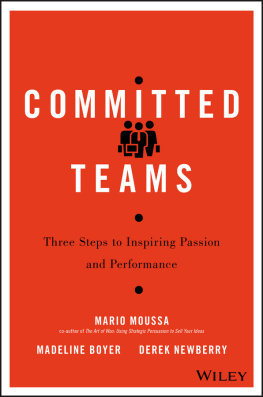Leadership teams captures the breathtaking effects of the driving force of a team. Vadim Makhov, Chairman of the Board of Directors, Severstal, Russia
This book is a practical and insightful guide to modern team leadership. Peter Steane, Emeritus Professor, Macquarie University, Australia
As we struggle with unprecedented environmental problems at the same time as economic uncertainty, effective leadership and team work has never been so critically important. Juliet Roper, Professor of Management Communication, University of Waikato, and Associate Dean, Sustainability, University of Waikato Management, New Zealand
A well-written text combining intellectual insight with practical common sense. Dr Ian Brooks, Dean, Northampton Business School, UK
Other books by Andrew Kakabadse and Nada Kakabadse
GOVERNANCE, STRATEGY AND POLICY: SEVEN CRITICAL ESSAYS (2006) (eds.)
CORPORATE SOCIAL RESPONSIBILITY: RECONCILING ASPIRATION WITH APPLICATION (2006)
(Andrew Kakabadse & Mette Morsing (eds.))
CSR IN PRACTICE: DELVING DEEP (2007) (eds.)
SPIRITUAL MOTIVATION: NEW THINKING FOR BUSINESS MANAGEMENT (2007)
(Jeremy Ramsden, Shuhei Aida & Andrew Kakabadse)
LEADING THE BOARD (2008)
LEADING FOR SUCCESS: THE SEVEN SIDES TO GREAT LEADERS (2008)
(Andrew Kakabadse, Nada Kakabadse & Linda Lee-Davies)
THE ELEPHANT HUNTERS: CHRONICLES OF THE MONEYMEN (2008)
(Amielle Lake, Andrew Kakabadse & Nada Kakabadse)
Leadership teams
Developing and sustaining high performance
Geoff Sheard
Andrew Kakabadse
and
Nada Kakabadse


Geoff Sheard, Andrew Kakabadse & Nada Kakabadse 2009
All rights reserved. No reproduction, copy or transmission of this publication may be made without written permission.
No portion of this publication may be reproduced, copied or transmitted save with written permission or in accordance with the provisions of the Copyright, Designs and Patents Act 1988, or under the terms of any licence permitting limited copying issued by the Copyright Licensing Agency, Saffron House, 6-10 Kirby Street, London EC1N 8TS.
Any person who does any unauthorized act in relation to this publication may be liable to criminal prosecution and civil claims for damages.
The authors have asserted their rights to be identified as the authors of this work in accordance with the Copyright, Designs and Patents Act 1988.
First published 2009 by
PALGRAVE MACMILLAN
Palgrave Macmillan in the UK is an imprint of Macmillan Publishers Limited, registered in England, company number 785998, of Houndmills, Basingstoke, Hampshire RG21 6XS.
Palgrave Macmillan in the US is a division of St Martin's Press LLC, 175 Fifth Avenue, New York, NY 10010.
Palgrave Macmillan is the global academic imprint of the above companies and has companies and representatives throughout the world.
Palgrave and Macmillan are registered trademarks in the United States, the United Kingdom, Europe and other countries
ISBN-13: 9780230201903
ISBN-10: 0230201903
This book is printed on paper suitable for recycling and made from fully managed and sustained forest sources. Logging, pulping and manufacturing processes are expected to conform to the environmental regulations of the country of origin.
A catalogue record for this book is available from the British Library.
A catalog record for this book is available from the Library of Congress.
10 9 8 7 6 5 4 3 2 1
18 17 16 15 14 13 12 11 10 09
Printed and bound in China
CONTENTS
List of figures
Foreword
Preface
Acknowledgments
About the authors
Chapter 1 Conceptual framework
Leadership in the 21st century
Group development
Want to know more?
Chapter 2 Mobilizing
Group development
Practical indicators
Forming the group
Creativity and innovation
Decision making
Ways of working
Fitting behavior
Key learning points
Want to know more?
Chapter 3 Confrontation
Group development
Practical indicators
Understanding conflict
Managing conflict
Fitting behavior
Key learning points
Want to know more?
Group development
Practical indicators
Work-based relationships
Working in groups
Fitting behavior
Key learning points
Want to know more?
Chapter 5 One step forward, two steps back
Group development
Practical indicators
The way things are done around here
Competencies and capabilities
Fitting behavior
Key learning points
Want to know more?
Chapter 6 Behaving as one
Team development
Practical indicators
Teams working with other teams
Engaging others
Fitting behavior
Key learning points
Want to know more?
Chapter 7 Facing the future
Team development
Practical indicators
Managing yourself
Developing leaders
Fitting behavior
Key learning points
Want to know more?
Chapter 8 Grace under pressure
Grounded under pressure
Resilience under pressure
Adaptability under pressure
Maturity under pressure
The audacity of hope
It's only a model
References
Index
FIGURES
1.1 The integrated group development process
2.1 The integrated group development process, stage one: Mobilizing
3.1 The integrated group development process, stage two: Confrontation
4.1 The integrated group development process, stage three: Coming together
4.2 Driving change
5.1 The integrated group development process, stage four: One step forward, two steps back
6.1 The integrated group development process, stage five: Behaving as one
7.1 The integrated group development process, stage six: Facing the future
8.1 The integrated group development process
FOREWORD
I have spent my professional life working in and with teams. I can vouch that poor performance of teams is at the root of those issues friends and colleagues raise with me most frequently. The importance of knowing how to transform a group of individuals into a high-performing team can't be overstated. The need for people, in every walk of life, to work together was never more pressing than it is today. That is why this book is so relevant. Leadership teams explains how real people facing real problems can learn to create high-performing teams. It explains what ordinary people need to do if they are to get extraordinary results.
The authors of Leadership teams use a new development of well-proven theory that is rooted in a pragmatic and practical approach to leadership action and team development. They use an academically sound basis to clearly define what leadership action means in practice. The book focuses on the leadership capabilities you must develop and learn to deploy. Critically, the authors clarify the process of group life that plays out when people work together. In so doing they provide insight into why people behave the way they do when working together and, perhaps most importantly, what you should do about it. By providing insight into what can otherwise appear to be the irrational behaviour of others,
Next page










